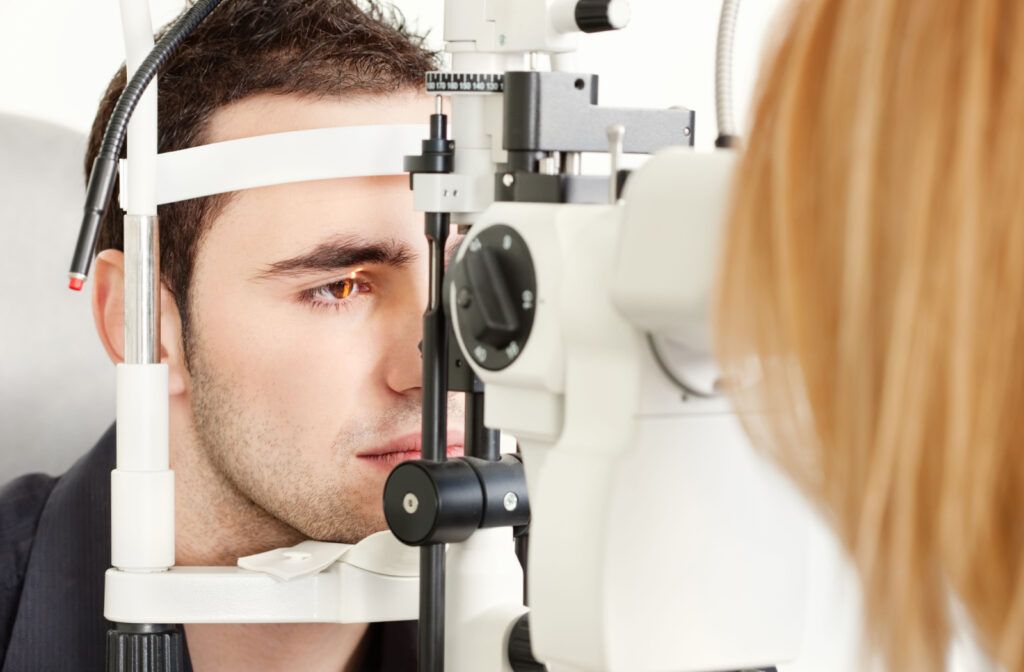The human eye is an incredibly complex part of your body, and it’s responsible for your ability to see the world clearly. But sometimes, something can go wrong and lead to refractive errors like myopia or hyperopia. While your optometrist can help treat these conditions, many people find themselves asking: what’s the difference between myopia and hyperopia?
Myopia, or nearsightedness, develops when the eye is too long and causes difficulty seeing distant objects clearly. Meanwhile, hyperopia, or farsightedness, causes nearby objects to appear blurry while distant objects are clearer.
What Is a Refractive Error?
Think of your eye like it’s a camera. There’s a clear lens at the front that bends the light in towards all the complicated internal mechanisms. These internal systems take the light and turn it into a clear image of your environment, and you can see the world around you.
When everything works in unison, it’s great! You can clearly see with no problems. But what if the light doesn’t bend right or doesn’t reach the right area? What if something’s shaped a little weird, causing light to refract incorrectly? That’s a refractive error.
Usually, this is due to a problem with the shape of the eyeball itself or the curve of your lens. Sometimes as you grow, they don’t stay perfectly rounded—the eye can grow too long or too wide, or maybe the lens doesn’t curve properly. When a refractive error develops, light doesn’t refract properly into the eye, so the internal systems of the camera aren’t able to build a clear image. Instead, depending on what you’re seeing, things get blurry.
What Is Myopia?
Myopia, also known as nearsightedness, is a refractive error caused by the eye growing too long or the cornea curving too much. This causes light to focus in front of the retina (the light-receptive cells at the back of the eye) instead of on it. As a result, things get blurry the further they are from the eye.
This condition often causes:
- Blurry vision
- Headaches
- Eye strain
- Squinting (especially when trying to focus on something at a distance)
Typically, myopia develops around the age of 8 or so. This condition is progressive, so symptoms usually get worse until around the age of 20. During this time, the eye continues elongating, so vision tends to get worse until the eye finally stabilizes.
It’s unknown exactly why this condition develops, but it’s understood that genetics play an important role—if one or both parents have myopia, a child is much more likely to develop it. At the same time, it’s believed that there’s a correlation between time spent outside and myopia development; children who spend 2 hours a day or more outside are less likely to experience this condition.
What Is Hyperopia?
Hyperopia, or farsightedness, is kind of like the opposite of myopia. It develops when the eye grows wider than it is long, or the cornea is too steep. When this happens, light rays focus behind the retina rather than on it. This leads to difficulty focusing on nearby objects while distant objects are clear.
Hyperopia often causes:
- Difficulties with close-up tasks like reading or sewing
- Eye strain when looking at things up close
- Aching or burning eyes
- General fatigue during tasks that require intense focus on nearby objects
Similar to myopia, though, it’s believed that genetics play a role in whether or not a person will develop hyperopia.
How to Treat Myopia & Hyperopia
There is good news, though: both myopia and hyperopia can be treated with the help of your optometrist. Usually, treatment aims to alter how light enters the eye to accommodate how your eye is refracting these rays. This is often done through eyeglasses or contact lenses.
However, there is a more permanent solution for adults looking for a long-lasting answer to their refractive error. Corrective surgeries like LASIK or PRK can be performed if you’re an eligible candidate. These surgeries aim to permanently alter your eye’s natural lens so it can refract light properly, so you won’t need other types of vision correction anymore.
However, it’s important to note—not everybody is a candidate for these surgeries. If you’re thinking about corrective surgery, you’ll need to visit your optometrist for a laser eye surgery consultation with your optometrist. They’ll perform a comprehensive exam to determine whether or not corrective surgery could work for you or if you need to try something different.

What to Do if You Have Vision Problems
If you’re experiencing a problem with your vision, come visit our team here at Spectrum Eye Care. We can perform a comprehensive eye exam to determine whether or not you have a refractive error, and once we provide a diagnosis we can recommend an appropriate treatment. You deserve clear vision, so book an appointment with our team today!

